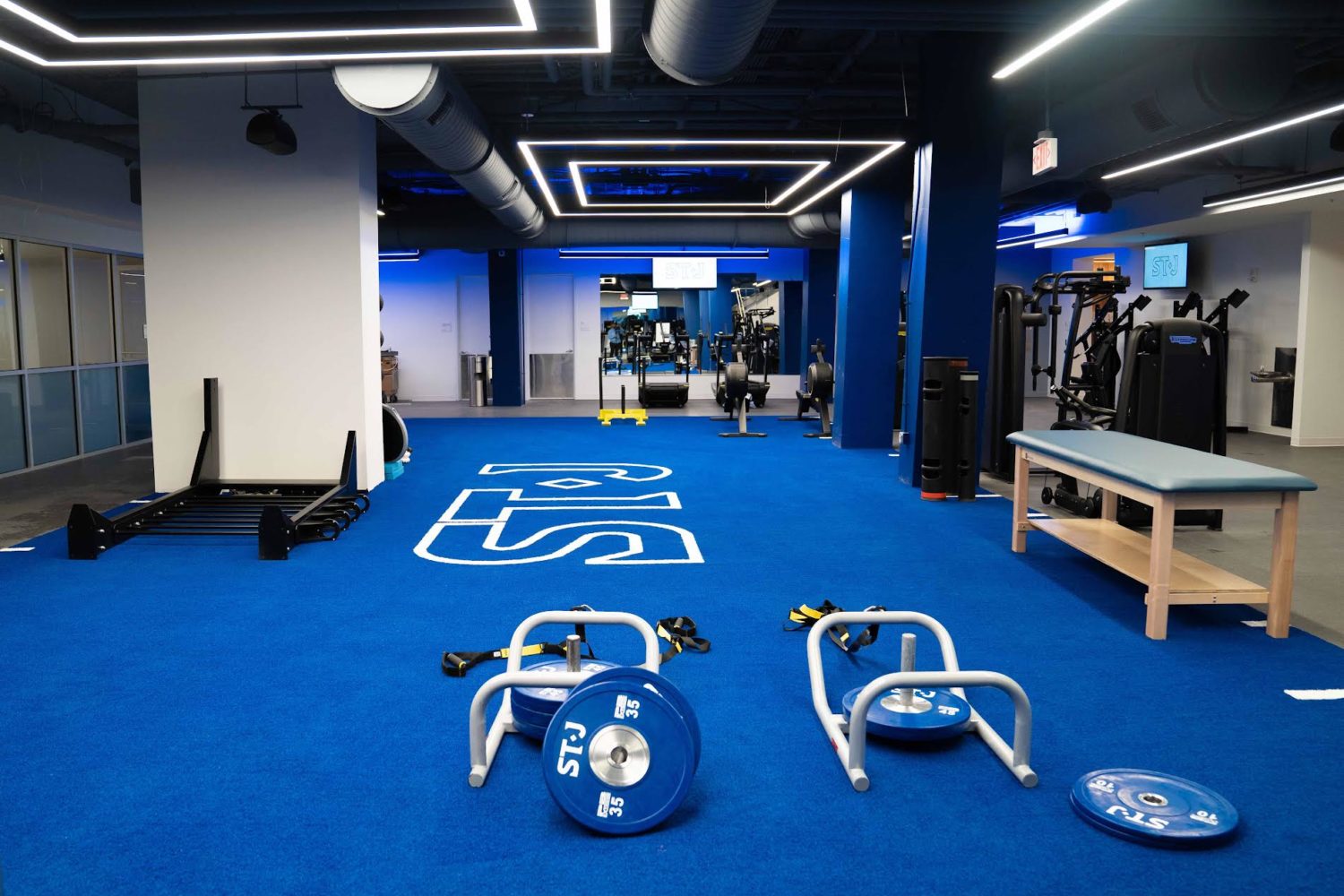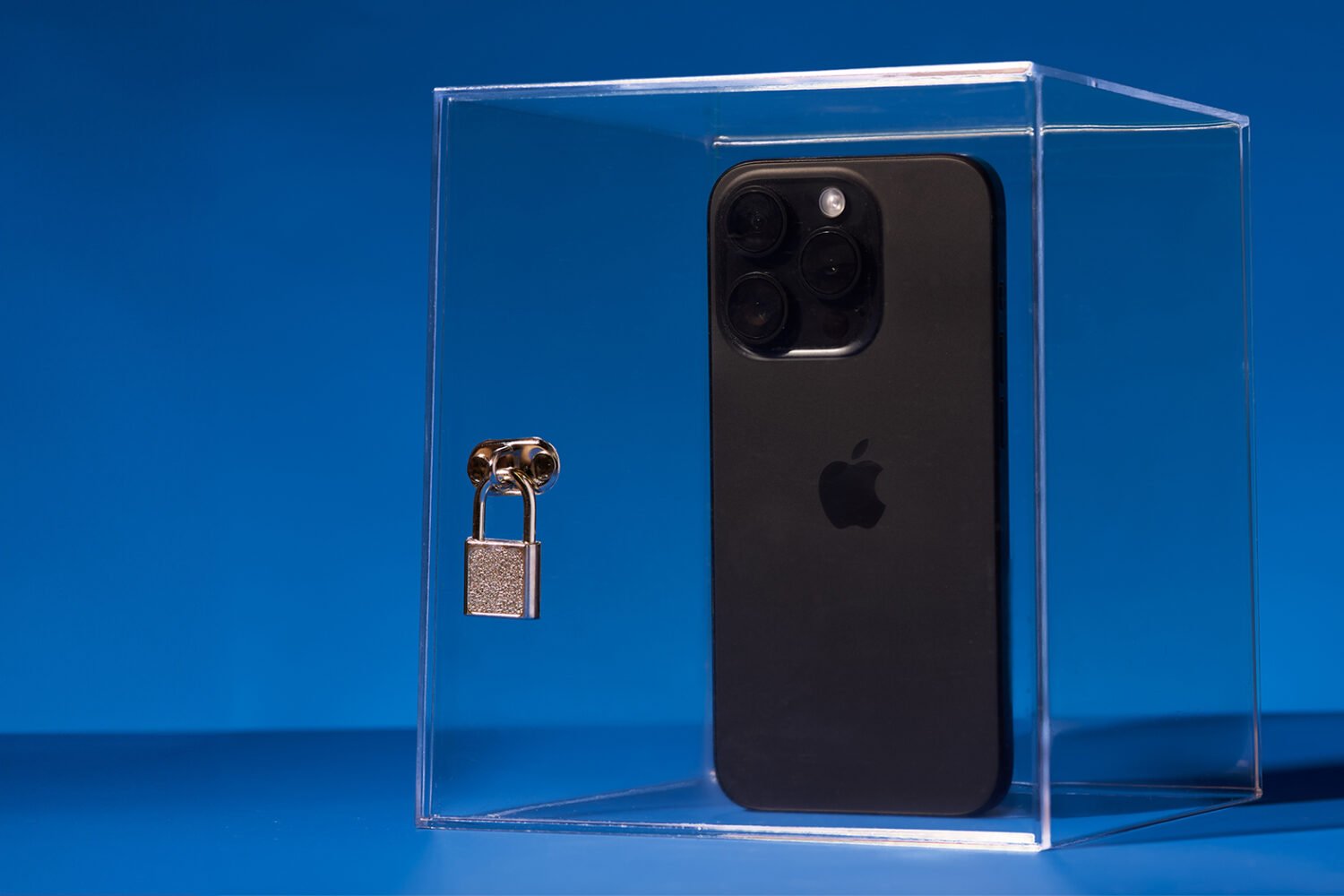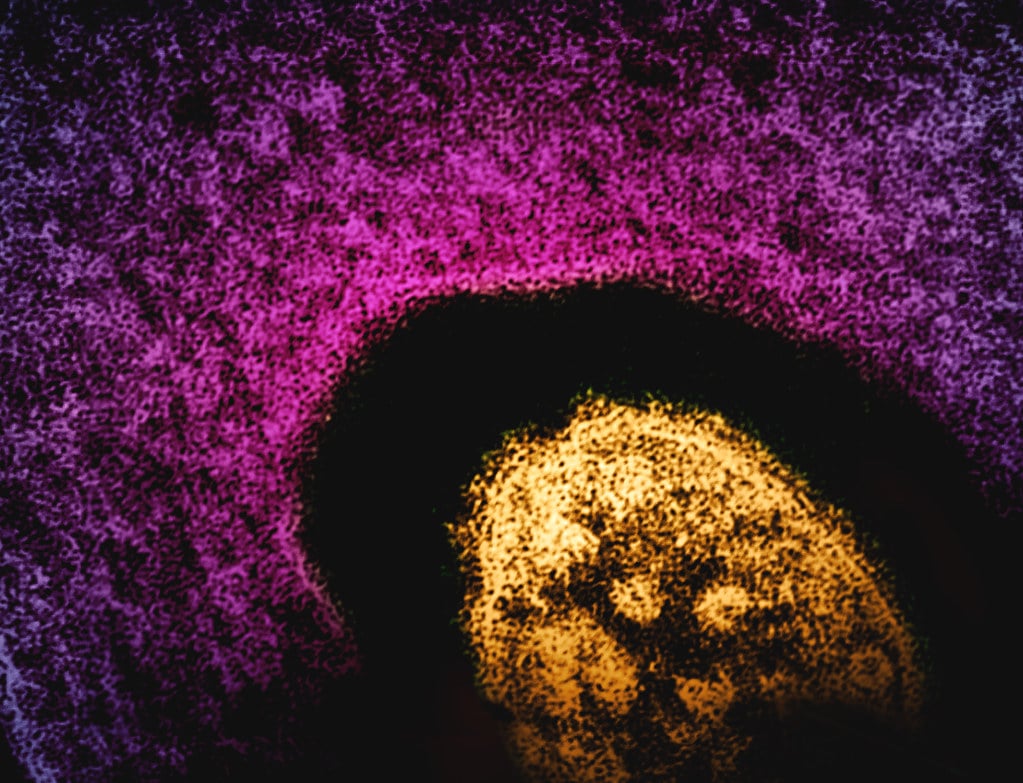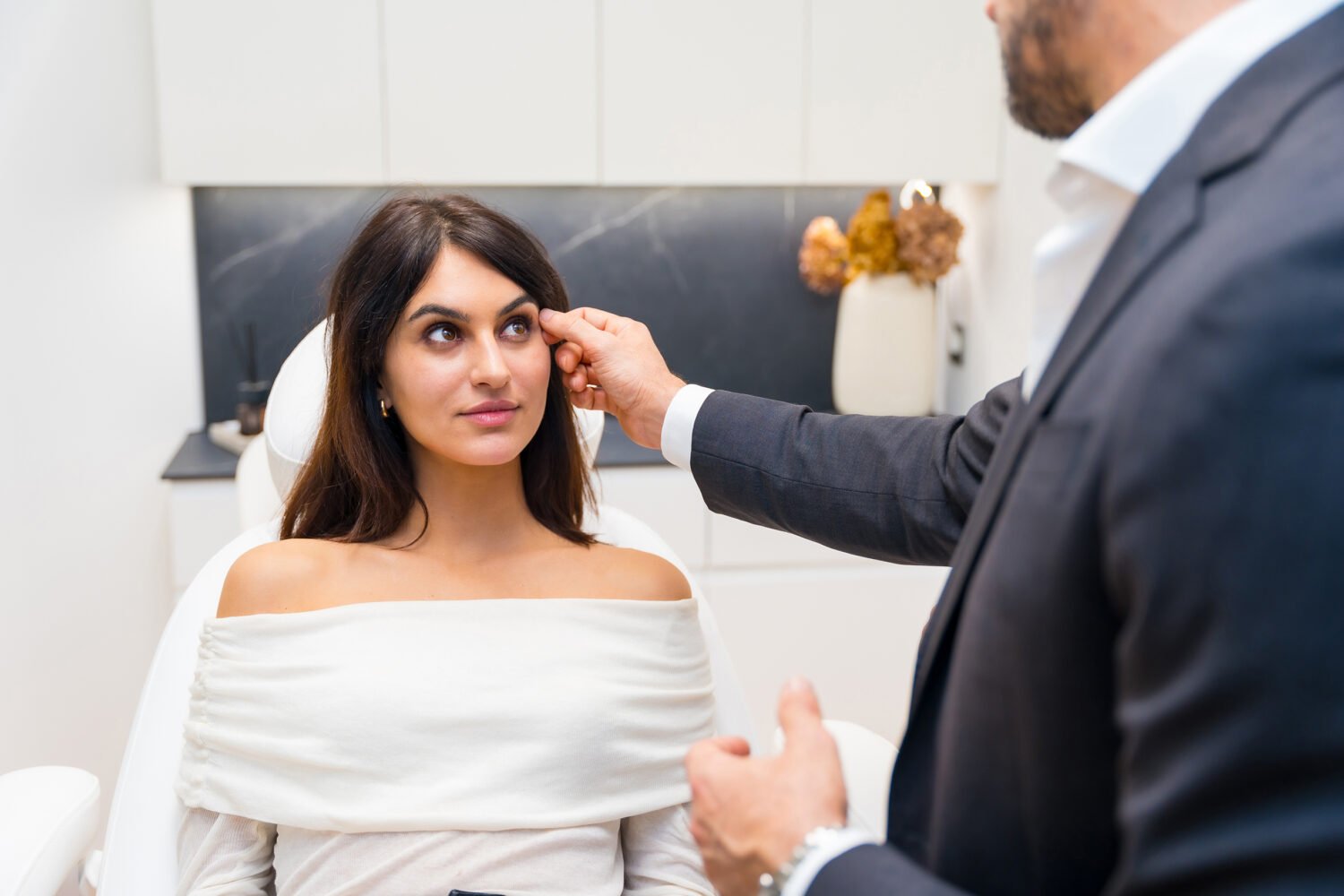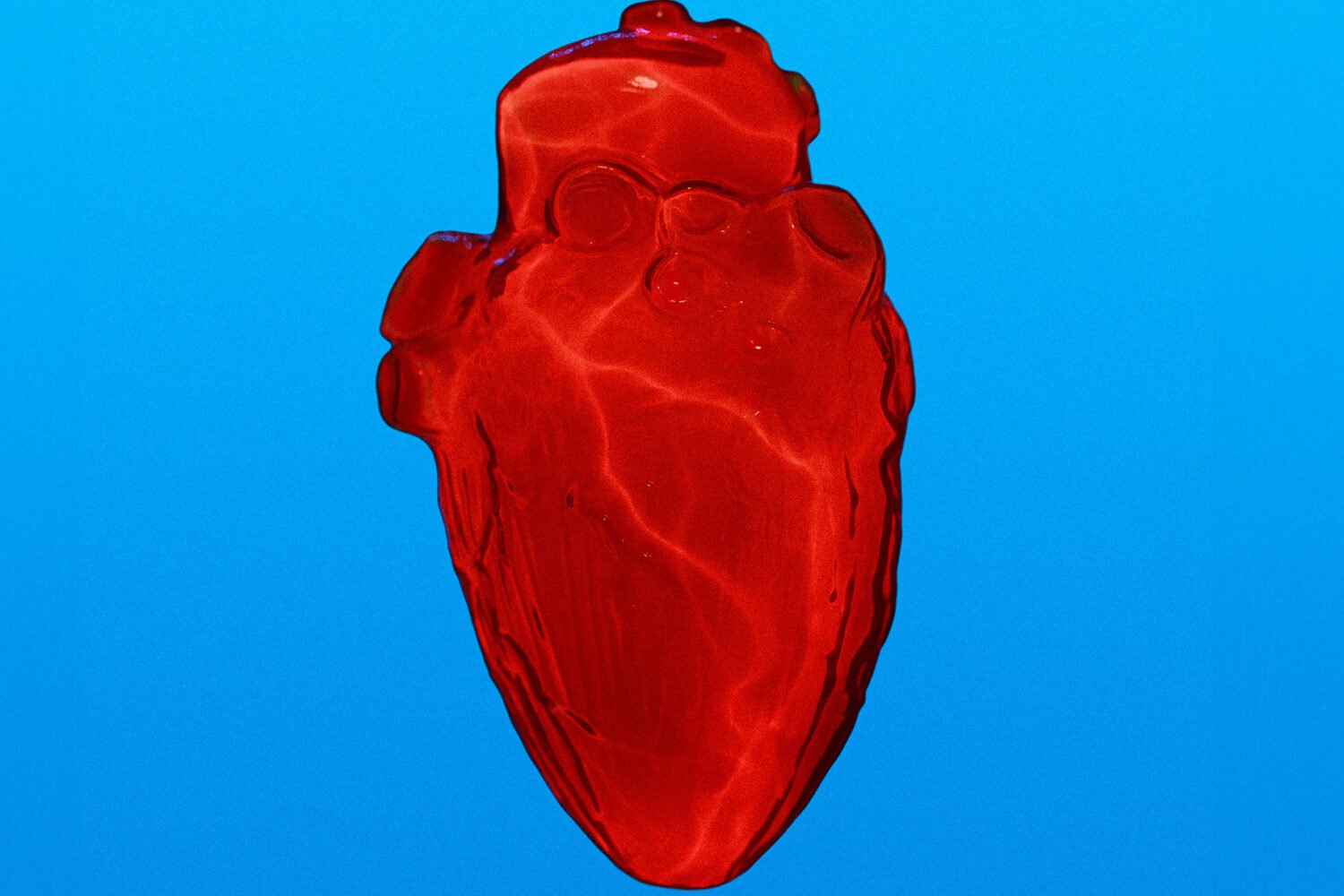IT WAS THE SUMMER OF 1999, THE summer three people died, in separate incidents, by walking onto the railroad tracks at Rockville's Randolph Road ahead of a speeding locomotive.
For the second weekend in a row, I'd spent every second in agony. Unrelenting pain on one side of my head had left me dizzy, nauseated, and wrung out. Prescription medications, painkillers, ice packs, stretching, massage, darkness and rest–all common recommendations, and all no match for this migraine.
You know how a plastic doll looks once the family dog has mauled it? That was me at 2:40 AM, sprawled on the bathroom floor. An antinausea drug had done nothing. I didn't have strength left to sob.
"Please," my partner, Ray, begged, "I've called the doctor's service, I've called the pharmacy–is there anything else I can do?"
"Now I know," I whispered, "why women walk in front of freight trains."
That no one dies of migraine seems, to someone deep into an attack, an ambiguous blessing.
–Joan Didion, "In Bed,"
The White Album, 1979
Late 1993-early 1994. It all starts with a tingle. Standing in a Metro train, I sense a series of pinpricks below my left shoulder blade. Over weeks, the tingle increases, and a weight settles into my shoulders. I'm exhausted–stress at work accounts for that. Then comes an earache.
I can't read, I can't write, I can't think. Just looking at the computer hurts. Two Advil, then four, have no effect.
Forty-eight hours after the earache began, it melts away.
Without knowing it, I've just had my first migraine.
Eventually, anguish and an empty Advil bottle drive me to the nurse practitioners at Kaiser Permanente, my HMO, where every couple of months someone takes a look and pronounces me in fine health. Once, insisting on inner-ear distress, I'm told to take a decongestant. It makes me dopey but otherwise does nothing.
Various doctors progress to anti-inflammatories and muscle relaxants, which spin my head and churn my stomach. With every earache, I gulp more Advil. They dull the pain by maybe 5 percent.
Fall 1994. Kaiser assigns Dr. H. as my primary-care physician. She's an empathetic listener, but I'm wary when she suggests daily, long-term use of amitriptyline: What is this stuff? Are you sure it's not addictive?
It's an antidepressant in larger doses, she says; it should relieve pain and make you a little sleepy, and no, no, it's not addictive. So every night I take two ten-milligram pills. The weight lifts off my shoulders. Dr. H. raises the dose to 25 milligrams.
July 1995. For days this headache has been pulling nerves taut, contorting my body. I thrash on the bed, crying but unable to speak. Ray insists we head for Kaiser's quasi-emergency room in Kensington.
Dr. John Wright takes a history, looks in the ear, then probes my neck and spine. "T6," he says, explaining that T (for thoracic) and 6 refer to the location of a strained back muscle. "What have you been taking for this?"
Ibuprofen and acetaminophen–every few hours around the clock. Up to 4,000 milligrams a day.
"Good lord," he says. "You're risking severe liver and kidney damage."
Uh-oh. But at last we have something to work with: Wright thinks there's a connection between the T6 and the earaches.
That inkling only gains strength when my employer's computer consultant happens past my office door. "Don't do that!" he sputters.
"Do what?"
"Sit like that!"
I'm the perfect "don't" model for an ergonomics poster: legs crossed, knees pointed to one side of my L-shaped desk, torso twisted toward the other, one shoulder propping up the phone.
I start putting pieces together: The twist in my back is the site of that original tingle–and near the T6 muscle. Hmm.
If you're not dying, the gears of an HMO can turn slowly. Not until spring 1996 does a round of tests begin: two MRIs, one CT scan, x-rays, tests for carpal tunnel syndrome, Lyme disease, lupus, and rheumatoid arthritis. All negative, so we're back to a back spasm–I guess.
I'm prescribed Tylenol with codeine–which doesn't touch the earaches–and Robaxin, 500 milligrams twice a day, to reduce muscle spasm and tension. It's scary stuff: MAY CAUSE DROWSINESS. USE CAUTION DRIVING. USE CAUTION WITH OTHER DEPRESSANT-TYPE DRUGS. MAY CAUSE DIZZINESS. AVOID HAZARDOUS ACTIVITY. MAY CAUSE BLURRED VISION. REPORT ITCHING/HIVES/BREATHING PROBLEMS TO DR.
July 1996. A new job means leaving Kaiser, which has taken good care of me for a decade. And what if Cigna HMO considers whatever this is a preexisting condition? How do I explain something I don't have a name for?
Concerned friends have a name for it–migraine, a condition shared by up to 45 million Americans. (They're called "migraineurs.") But no doctor has agreed, and when I look up the definition, it says nothing about ears. It insists on throbbing or pulsating pain; mine is steady and dull.
The severity and queasiness fit, though, often forcing me to leave work early. Funny, there's never any trouble getting a handicapped seat on Metro–one look at my face and the Red Sea parts. I count backward from 100 by sevens to distract the nausea: "93. 86. 79. Just until we reach Rockville. 72. 65. 58. Please. . . ."
Summer 1997. My primary physician, Dr. T., sent me to an osteopath, who did chiropractic adjustments and pointed to a medical text to show how various back muscles can refer pain to parts of the head. Aha–Wright was right!
The osteopath prescribed two months of physical therapy. Stretching exercises strengthen my back and neck. Therapeutic ultrasound loosens tight muscles and increases blood supply, which promotes healing. Cortisone shots reduce swelling in the trigger point.
Physical therapy gets me a TENS unit–for transcutaneous electrical nerve stimulation–that intermittently zaps surface nerves through electrodes taped to the skin, blocking the transmission of pain signals. I'm the office curiosity, wired to what looks like a Palm Pilot with dials, but the gizmo depletes pain referred from the back muscles by half.
Ray and I have bought neck-support pillows and microwavable heat wraps. He rubs the "bricks" out of my shoulders every morning. I do stretches twice a day, parcel out pills, keep a diary of symptoms. But the earaches pay no mind. After debilitating attacks on plane flights, I've seen both the Salt Lake City airport and Atlanta's Coca-Cola museum from a wheelchair.
Studies say migraine costs $13 billion to $17 billion a year in missed work and reduced productivity. If that's what these are, I'm helping to keep those numbers high.
New prescription: Ultram, 50 to 100 milligrams as needed. After getting carsick, I learn the hard way not to take painkillers on an empty stomach.
A common scenario is the headache patient who has been mismanaged by various primary-care physicians and is not seen by a specialist until he or she has a severe disorder compounded by depression and dependence on analgesic medications.
–National Headache Foundation
December 1997. Again I go through it with Dr. T.: unendurable pain, nausea, fatigue; nonresponse to meds; having to use seven sick days in nine months (annual allotment: five). "I can't take it anymore," I tell her. "I can't work, I can't function. Please–I'm desperate."
Dr. T. frowns: "Hmm. If that's the case, maybe a psychiatrist would be helpful."
Everyone has her limit, and that's mine. I demand a referral to a neurologist and a chiropractor. Then, first thing back at work, I switch primary-care physicians. Any doctor who sees all this as an emotional problem has got it backward.
January 1998. Neurologist Al Galdi takes a medical history. Any migraine in the family? My mother, an only child, had a few in her twenties; my father and his childless brother don't seem to have; farther back, not that we know of.
Next comes the tapping of elbows and knees to test reflexes, an ophthalmoscope for the eyes, and coordination exercises: With eyes closed, can I touch the end of my nose? If I hold my arm out, can he can push it down? He's trying to rule out a brain tumor, aneurysm, or structural disease.
Official diagnosis, four years late: migraine without aura. (An aura is one or more warning symptoms, such as visual distortions.) Galdi hands me a prescription for Imitrex, the first drug–introduced in 1993–to fight not pain but the mechanisms of an attack.
News accounts have linked dozens of "adverse effects" to Imitrex–including heart attacks and strokes–but the warnings have been strengthened, and my heart was tested and declared healthy. Over dinner one night, I weigh the dangers against the misery this pill might dislodge. Misery wins; down it goes.
Results are ambiguous. But another night, shaking and in tears at a Caps game, I break open an Imitrex nasal spray (no water needed–good for the migraineur on the go). Nasty-tasting, but 25 minutes later I'm cheering Olie the Goalie, all pain a thing of the past. God bless GlaxoSmithKline pharmaceuticals.
A diagnosis opens a world of discovery. I learn about headache triggers: red wine, aged cheese, monosodium glutamate, nitrates, nuts, beans, aspartame, chocolate. Changes in air pressure–weather, plane flights (aha–that explains my collapse at Salt Lake!). Hormonal fluctuations (hence the three-to-one prevalence in women). Exertion. Too little or too much sleep. Missed meals. Loud noises. Odors. Bright or flickering lights. Stress, of course.
Caffeine can start a migraine. Caffeine can stop one. It's enough to give you a headache.
CHIROPRACTOR ROBERT RIFKIN GOES after the migraine and T6 muscle with manual adjustments; ultrasound, microcurrent, and massage to neck and back; and a new diet. He can customize the basic trigger list using diagnostic biofeedback, which measures heart rate, blood pressure, and temperature. Biofeedback patients may learn some control of these functions to minimize symptoms; here, responses show what I'm sensitive to. After a test of about 20 minutes, he prints a list of foods to avoid: sugar, dairy and wheat products, citrus fruits, chocolate, nuts, soy sauce . . . and about 80 more.
"This is everything I eat," I say. "All that's left is vegetables? Even for us vegetarians, that's absurd."
Well, that's not all that's left. Onto the kitchen shelves go rice milk, oatmeal, and more fruit than usual. Easy on the tofu, and no more treats of red grapefruit. When Ray loads his tacos with shredded cheddar, I try not to gaze at it longingly.
But after several months' inconvenience and migraines still taking an average of seven days a month, I begin integrating "taboo" foods back into the diet. Though some triggers do seem to set off a headache when eaten in quantity on an empty stomach, most show no correlation when part of a meal.
Stupid Drug Tricks
March 1998. Pharmacy errors cause my nightly amitriptyline–now up to 50 milligrams–to run out. I've forgotten what it's for, anyway. I'm forgetting a lot of things lately–getting confused, losing my train of thought. And feeling dizzy and motion-sick on Metro.
As insomnia blankets the week, things get worse. The office hallway pitches and heaves. Hanging onto a wall, I phone my new, more-supportive primary, Dr. G., in a panic.
Withdrawal symptoms, he says: "Amitriptyline is addictive. Who told you itwasn't?"
Dr. G. prescribes a new, minimal dose to help. Meanwhile, migraines start kicking me awake at 4:30 AM. And they no longer last just 48 hours–sometimes less now, but sometimes more.
Mid- to late 1998. Excedrin–a combination of aspirin, acetaminophen, and caffeine–can stop a brewing headache in its tracks, I find, but once things get past that stage, Excedrin is powerless. I pay more attention to the earliest warning signs.
Catching a migraine early has its downsides. One day after diverting an attack, I bump my arm. It's a forgettable injury, but with so much aspirin in me, the blood flows freely. In summer's heat, I wear long sleeves for two weeks to cover a bruise the size of my fist.
In July, I'm beat after taking nine Imitrex in 4H days. That's quite against the fine print, but what should I do–check out for a week? My friend Irene, a nurse, regularly pops two Imitrex at a time. That's against the rules, too.
Somehow I learn that one of amitriptyline's uses is to prevent migraines by regulating serotonin levels. Why hadn't anybody said so? I ask for a full prescription again. Still, around Labor Day, one migraine lasts two weeks straight.
Imitrex has turned on me, causing extreme dizziness, racing heartbeat, and fatigue. Dr. G. says it's a rare reaction and switches me to Zomig, Imitrex Nasal, and Amerge–all triptans, the family of drugs that targets migraine. I also begin B2 vitamins, 400 milligrams a day. Studies say that amount may help prevent attacks, and there appears to be no harm of overdose.
Dr. Galdi prescribes Cataflam, a painkiller mainly for osteoarthritis and rheumatoid arthritis, which causes dizziness and disorientation. It soon joins the growing number of abandoned bottles on my shelf. B2 and amitriptyline are all I'm taking daily.
January 1999. I feel about needles the way Indiana Jones feels about snakes, but these headaches are very persuasive. Warily, I take Dr. Rifkin's acupuncture referral to Dr. Michael April, a rehab specialist who works with athletes and headache sufferers.
Acupuncture has been used in China for millennia to treat everything from toothaches to childbirth pain. The theory is that with illness or disease, the body's energy is out of balance. Tapping into meridians–rivers of bodily energy flow–is supposed to restore balance.
Dr. April places tiny needles along my arms, legs, feet, and scalp and connects them with lightweight electrical wire. Generally I doze off, content that I'm in good hands. The needles hurt only at first, and acupuncture has few risks.
Migraine attacks soon drop by 50 percent, and some are milder than before. These happy effects last a few months. But by spring, the headaches are back with a vengeance. For many patients, successive treatments reinforce themselves for extended periods, but there can also come a plateau. For me, inexplicably, all gains have been wiped out.
May 1999. Late afternoon. The pain comes on fast–very fast–just right of the base of the skull. Hyperventilating and nearly doubled over, I phone Dr. G.
"If it's the worst headache of your life," the advice goes, "head for the emergency room." My doctor says the same. A burst of severe pain could indicate a subarachnoid hemorrhage–bleeding beneath a membrane enclosing the brain and spinal cord. This rare condition can be fatal.
At George Washington University Hospital, an ER doctor asks me to describe the pain. "Like–being hit–with–a bat," I gasp, pointing two inches above my hairline in back.
After ordering x-rays and a CT scan, three doctors confer, noting my dull eyes, shakiness, and pallor. As several hours pass I become more lucid, and by 9 PM there's no clear conclusion. An ER doc hands me Percocet–a narcotic analgesic–and water. Woozy all the way home, I step out of the passenger seat and get sick (Percocet's main side effect).
A statement comes in the mail from GW. THIS IS NOT A BILL, it says, nonetheless noting that my evening in Foggy Bottom cost $1,204.25, including $4 for the Percocet. The same statement, which insurance reduces to $158, arrives every month for the next year and a half, then mysteriously stops.
Headache leads to 2.4 million ER visits a year, says Merle Diamond, an emergency physician and associate director of Chicago's Diamond Headache Clinic. Migraine costs the economy $1 billion a year, according to GlaxoSmithKline; sufferers run up almost twice as many medical claims as the general populace–and 2H times more pharmacy claims.
Summer 1999. With headaches growing in force, Dr. G. pushes me to consider long-term preventive medications in addition to amitriptyline: calcium channel blockers, beta blockers, or Depakote.
Calcium channel blockers relax blood vessels and increase the heart's supply of blood and oxygen. One or more can help prevent migraine and treat and prevent a subarachnoid hemorrhage. However, according to my research, these may cause depression and symptoms similar to Parkinson's disease; increase heart, liver, and kidney problems; and interact with other substances.
Besides, more than one source says these drugs aren't terribly effective. No, thanks.
Beta blockers are used primarily to treat high blood pressure. Side effects include fatigue, slowed heartbeat, nausea, digestive problems, insomnia–and headache! Dr. G. emphasizes the fatigue and a need to "take it slow." Pain is one thing, but living every day in slow motion?
Online, I find scarier warnings from the FDA: beginning or worsening of heart failure (shortness of breath, coughing, weakness, weight gain, and swelling of feet, ankles, and lower legs), breathing difficulty, confusion, hallucinations, depression, and cold hands and feet. Forget it.
As for Depakote, an epilepsy treatment, the manufacturer warns strongly of liver failure, pancreatitis, and more. This stuff makes Robaxin look like a sugar pill.
Late 1999. Disability retirement has crossed my mind.
Migraine sometime shows up two or three times a week for days at a time. I've become something of a recluse, unwilling to make plans for fear of having to cancel. Attacks now intrude on every birthday, holiday, and vacation. Christmas week alone requires 20 doses of medication; I lie in the darkness, the pillow wet with tears, while Ray's family makes merry in the next room.
Ray is used to a two-person household. We divide the chores. With me increasingly out of commission, he's been taking on all the shopping, errands, cooking, laundry. Several times he's arrived home to find me semiconscious on the dining-room floor, too weak or ill to reach the kitchen.
He's as frustrated as I am, and there are limits to his sympathy–which is natural, especially when the culprit isn't visible. He resents missing a game, a favorite show, or a night out when I'm suddenly unable to care for myself. Grumbling overtly or covertly, he'll fix me a meal, set up a tray on the bed or couch, fetch drugs and water, then head off for whatever he'd planned to do–if that's still an option.
We've been together since 1990. At first those earaches were an occasional distraction. But as months became years, they wove their way into our life. We approached and passed the point where migraines had intruded on half our relationship; now it's more than two-thirds.
Am I now a person who has headaches or a person defined by them?
Early 2000. I've learned to be super-productive on good days because I'm a zombie on bad ones. Weekends are a wash: When not lost to illness, they're lost to work to make up for days of zombiedom.
Dr. April has sent me to physical therapy, where Ira Silverstein's people teach me everything from walking and sitting well to strengthening back and neck muscles to better support my head. All this may help prevent headaches–and conversely, sloppy posture may have helped cause them.
One therapist asks if I grind my teeth. The dentist sees no evidence, though I sometimes wake up with them clenched. Could TMJ–a painful jaw condition often connected to migraine–be a factor? But then, in line at CVS, I read about triptans in The Pill Book: "People have experienced chest, neck, or jaw tightness and pain after taking one of these drugs."
Chickens, eggs.
THE HEADACHE'S FAVORITE KICKOFF time is late morning, but 4 AM is popular, too. Remembering the results of painkillers on an empty stomach, I become skilled at walking downstairs in the dark, munching Triscuits, downing a pill with juice, and climbing back into bed without fully coming to. With luck, I'm headache-free by the time the alarm sounds.
Regretfully, I've decided to stop seeing Dr. Rifkin. I feel well cared for by him and his staff, and his treatments seem to have banished the T6 spasm, but the detailed calendar I keep shows that migraines have increased in the last two years. Presumably these attacks are from other sources. I drown my sorrows in bags of candy.
I'M FILLING 65 PRESCRIPTIONS A YEAR; the national average is 11. The clerk at CVS reaches for the "R" basket before I even reach the counter. To keep track of medicines, I create a chart. It grows to three pages. Not to mention the merry-go-round of generalists, referrals, specialists, HMO and pharmacy rules, conflicting information and advice.
I get a prescription for Zomig, usually the most effective of my stash of drugs. CVS won't fill it: "Your insurance says you need prior authorization from your physician."
"This prescription is from my physician."
"Sorry. You need prior . . . ."
After a few tries, I learn to work the system: Turn in the prescription; fax the doctor's secretary "our" rationale for the drug (so she knows what to say to CVS); she calls CVS; CVS calls Cigna; I finally get my drugs. Sigh.
December 2000. After an unexplained dip, the headaches are back to six days out of seven. They attack at midmorning, in the afternoon, on Metro in rush hour.
I hunch my shoulders against the cold, which doesn't help. "Muscles contract to generate heat for the body. It sets off a myofascial reaction," says Dr. Arnold Binderman, a Bethesda periodontist who specializes in TMJ. "Wear a warm shawl to avoid direct cold on the jaw and neck muscles and limit muscular contraction."
That's not all: Keep the body in good alignment but not stiff. Stretch every hour. Refill drugs before they run out. Exercise, but don't strain the neck. Watch the diet. Don't skip lunch. Don't stay up late. Don't sleep in. . . .
I'm so tired. Tired of the pain, the bills, the runaround, tired of being tired. Though I learned long ago to tune in to the mere stirrings of a headache, I sometimes deny the warning signs. No, I think, not now, not again, no. Please.
I give in. Dr. G. bumps the amitriptyline up to 75 milligrams and starts me on Depakote.
I'm researching biofeedback providers when–these drugs work. As my body adjusts, the combination starts cutting the migraines down to weekly, then to occasional (except for menstrual hell week). The clouds lift. The sun shines. Birds sing.
Of all the threatened side effects, the only noticeable one is dry mouth. I set up a humidifier in the bedroom and celebrate with a Krispy Kreme doughnut.
Spring 2001. After eye surgery in January, my ophthalmologist gave me a pair of sunglasses for a few days' protection–the big, ugly, plastic kind. Their full coverage fights the light sensitivity common among migraineurs, though. Walking out my door on a bright morning can feel like getting sliced through the eye. Who cares about that heckler a while back? I wear the elder-shades everywhere now, remembering Will Smith's line from Men in Black: "I make this look good."
Dr. G. has left the group practice, so I choose another primary-care physician, Dr. S. The new doctor frowns at the old one's prescriptions, particularly Depakote.
"No way," I say, all but clutching the bottle to my chest. "No stopping my Depakote."
Why doesn't she like it? The same reasons I resisted for so long–potential damage to the liver and pancreas, stomach problems, nosebleeds, hair loss, birth defects . . . things Dr. G. never mentioned. We compromise with a blood test for liver function. Luckily, mine's working fine.
THE BACK-OF-THE-SKULL-ACHE THAT sent me to GW's emergency room two years ago has cropped up since–always fast, always awful, though rarely as bad as that first time.
Because everybody knows migraines don't occur at the back of the skull, there's no sense taking a migraine drug, right? Instead, I load up on over-the-counter painkillers–so many as to make me sick to my stomach. After hours or days, I finally resort to a triptan and see an effect only after more hours. So was it or wasn't it?
Then I discover the developing area of chronic daily headache and rebound. Though "chronic tension-type headache" is officially more than 15 headache days a month for at least six months, the line between migraine and tension headache gets unclear at that frequency. Many experts believe these are not separate entities but points along a continuum.
There's also rebound, which can result from overuse of drugs, prescription or not. Overuse results in a continual headache pattern that wakes patients from sleep–but they may go through withdrawal if they stop the drugs.
I didn't hear all this from a doctor; I read it in the National Headache Foundation newsletter. So maybe Excedrin and such, rather than helping, have exacerbated the problem. Let's try getting off this whirligig.
Summer 2001. It finally happens: At the pharmacy, the cost of Amerge, Zomig, amitriptyline, and (ahem) peanut-butter cups is more than I have on hand.
The woman ahead of me doesn't have insurance. "A hundred twelve sixty-seven, please," the clerk says.
The slip of paper with each refill states how much insurance pays–if you have insurance. No generics available for these: Imitrex, full price $128.28. Amerge, $138.12. Maxalt, $84.19. Zomig, $43.12. Depakote, $147.57.
One way that insurance companies "capitate" costs is to limit patients to a set number of medications a month. As a migraineur, you weigh your pain against the number of pills you have left. What are the chances this attack will worsen–or that you'll have a nastier one later?
For a while with my insurance, prescriptions cost just $5 a box. Then the copay jumped sevenfold. Just as Cigna planned, I begin to hesitate upon feeling the signs: Is this for real? Would an analgesic do it, or would that risk rebound? Should I take a triptan? Do I need a whole one, or will a half work?
April 2002. I give two speeches at a Chicago conference without the slightest palpitation. I'm pressed into an impromptu "chat with the expert" session–no problem. Ray and I take a few days' vacation and drive home Sunday as rain pounds on the car for hours. All throughout, no migraine.
Monday morning I'm back at my office keyboard. And so is that headache.
Is it subconscious association–I'm at my 9-to-5 station, therefore I must be sick? Is it posture, muscles falling into headache-triggering alignment despite sitting up straight, feet flat on the floor, elbows on the armrests? Or a "letdown migraine," known to strike once stressful situations are past?
Time to find another specialist. I scour the area for a neurologist near home or work who offers biofeedback and also takes my insurance. The list narrows to Dr. P. Steven Macedo. My primary makes thereferral.
"So–you've been having migraine. Tell me what it's like."
"The headache usually presents slowly at the eardrum or just behind the ear," I begin. "Lately it creeps up in late morning or late afternoon, though it's come at dawn or late night, too. There's no aura. If untreated, it grows until the pain, dizziness, and nausea make it too hard to concentrate or even to walk straight. Noise and bright light make it worse, and sometimes rain, but I've noticed no particular food triggers. Less often it shows up in the forehead and at the base of the skull, sometimes at the same time, and in connection with neck and shoulder strain. Sometimes I wake with clenched teeth, and the jaw gets tight at times during an attack."
"You've done your homework," Macedo says.
"Eight years' worth."
He probes my jaw, neck, skull, and temples, notes what feels tender, and pronounces that I have migraine with three causes–neurogenic (pure migraine), cervicogenic (originating in the neck, home of nine ligaments and dozens of muscles), and TMJ/jaw alignment.
Macedo wants me to get treatment from others on his team: chiropractor Eric Meyer for neck and jaw work and psychologist Bob Stevenson for biofeedback, which can teach me ways to destress and redirect internal energy against the sources of migraine. He also refers me to Dr. Arnold Binderman, the Bethesda TMJ expert.
Meanwhile, he wants to replace Depakote with a newer medication "that won't chew up your insides." Studies show that Topamax, used against epilepsy, seizures, and bipolar disorder, also reduces recurring migraines by about half. He prescribes 75 milligrams morning and night.
Side effects? "You'll probably lose ten pounds. Women rarely object to that."
I laugh. My jeans haven't fit in three years.
Summer 2002. The affable Dr. Binderman determines that the cartilage in my jaw is out of position on both sides, a condition set off by incomplete orthodontia in adolescence: "The ligaments are lax, the muscles are extremely tight, and on the left, cartilage clicks in and out of place every time you talk or eat. I don't know that orthodontics today will solve the problem. Surgery might be needed."
Better that than this.
CT scans show the joint off-center in its socket, confirming Macedo's theory: The T6 muscle referred pain toward the ear years ago, but TMJ shows up in the same spot (the jaw hinge being next to the eardrum). Two causes, one result–migraine.
Binderman fashions an intraoral orthotic appliance–like a mouth guard–to wear at night. In the short term, this piece of plastic separates joints and removes 80 percent of the force, relaxing the muscles. Over time, it'll realign my bite and shift the jaw back into position. It doesn't hurt much, but the bill does: $1,595 for assessment, scans, and device, before monthly adjustments. His staff explains how to file for reimbursement–and how to appeal when denied.
AWARM NIGHT, A COOKOUT, THE company of friends. At 8 PM, I count out three Topamax, an amitriptyline, a B2, and magnesium. Somebody stares. "She rattles when she walks," Ray says.
Jill glares at him. "That stuff has put so much weight on me," she says sympathetically. "I can't keep my hands off the sweets."
Now it's my turn to stare.
"Oh, sure," she says. "Everyone knows amitriptyline piles on the pounds."
So that explains the candy cravings. Maybe it's not approaching-40 flab after all–it's the damn drug!
WITHIN WEEKS, THERE'S PROGRESS in my jaw. Muscles relax. Unhinged cartilage that bulged for years settles back flat. Surgery? "No way," Dr. Binderman says. "Adaptation is going very nicely."
Macedo, Binderman, and new drugs are now suppressing "regular" migraines to the point where those back-of-the-skull ones are the bigger problem. Given the history, it's a good problem to have. But they hurt–a lot.
The medical term for these is occipital neuralgia. Caused by irritation or injury to the occipital nerve, pain spreads from the back of the scalp up and around the forehead. According to the National Institute of Neurological Disorders and Stroke, this can result from physical stress, trauma, or repeated contraction of the neck muscles. Treatment: massage, rest, and in severe cases antidepressants, local nerve blocks, or steroid injections. (And triptans, at least for me.) Meyer's manipulation, microcurrent, and ultrasound are helping.
Some neurologists recognize occipital neuralgia as a form of migraine; others don't. I say if you haven't felt this agony yourself, yield to those who have.
December 2002. Wool slacks that stayed in the closet last winter zip with ease now. One explanation: My latest leisure reading, The Merck Manual of Medical Information, among others, says Depakote, too, leads to weight gain. Dropping that and adding Topamax have peeled off a pound a month, but that's not forever, and I don't want those cravings to return.
MedlinePlus, the National Library of Medicine's online database, reveals eight drugs in the same family as amitriptyline. I've cross-referenced what they're prescribed for, side effects, contraindications, and common dosages. Having also confirmed Jill's contention about amitriptyline and a sweet tooth, it's off to Dr. Macedo.
He agrees nortriptyline may be better. "All tricyclic antidepressants do the same job at preventing migraines," he says, "but yes, this one is cleaner"–fewer side effects.
Daily misery, gone. Rebound, under control (no more over-the-counter drugs). Back-of-the-skull-ache, getting there. Weight gain, gone. TMJ, almost gone. Can anything be done about menstrual hell week?
My gynecologist has retired, so I find a replacement. Reviewing the medical history, nurse practitioner Mary Kendell stops at my list of meds. "Estrogen-withdrawal migraines," she exclaims. "You should be on a lower dose of pill."
"We went to a lower dose four years ago. It didn't work."
"This is the highest of the low-dose pills," she says. "You've been going from 30 micrograms to zero in the fourth week of your cycle–no wonder you're miserable. This other brand is 20 micrograms, with a step down to 10 in between. Much less of a shock and just as effective."
Maybe we all should switch doctors regularly just for new information.
Next time around is much easier. Triptans' effects seem to last longer, and estrogen-headache attacks drop by half.
Migraine-free in 2003? No. But living a normal life, pretty much? Yes.
Headaches are down to a few a month, easily stopped with a triptan. The number of prescriptions I'll fill this year is about two-thirds less than in 2000. Topamax, B2, and magnesium have made even flying no problem. And I'm a far more informed, careful consumer of healthcare in general.
Optimism is fitting. Seven triptans are now available to kill migraines–apparently by blocking inflammation and affecting serotonin receptors–and others are in development. A migraine abortive called DHE, once only injectable, is now a nasal spray; it can be combined with an antinausea drug for those with "intractible migraine." And public awareness is growing.
The important thing is to find a headache specialist who can apply this growing knowledge to your own case. "Used correctly, we can control 90 percent of patients with the triptans," says DC neurologist Richard Edelson.
"Effective treatment is not the same as treatment," Merle Diamond notes. "Today, more than ever before, it pays to be persistent in seeking relief that's right for you."
Illustration for The Washingtonian by Francisco Caceres
WHAT'S GOING ON IN MY HEAD?
Migraine headaches affect one in four US households, according to the National Institute of Neurological Disorders and Stroke. But the numbers might be bigger: Only about half of migraine headache sufferers are identified, says Dr. Pamela Blake, head of Georgetown University Hospital's Headache Clinic. Why? They don't know treatment is available. They think their pain signals some other illness.
Or they're misdiagnosed. "Sinus headache is most likely migraine," says Blake. "Treat them properly, usually all headaches go away. More than half of patients with recurrent headache have migraine."
If your symptoms don't fit whatever pattern your doctor recognizes, you may miss an opportunity for treatment before the symptoms become debilitating.
"Medical students get maybe one lecture on headache in the whole curriculum," says Dr. Seymour Diamond of Chicago's Diamond Headache Clinic. Adds DC neurologist Richard Edelson: "Headache is economically nonrewarding. Many primary-care physicians don't understand it or don't have the time to delve in."
Migraine can be hard to pin down. The "classic" type–preceded by a brief aura of visual disturbances, difficulty focusing, and distorted perception or speech–accounts for just 10 to 20 percent of cases.
Related headaches complicate the picture. Muscle-tension headaches are a response to stress, anxiety, depression, or anger–and they can morph into migraines. These common headaches can be episodic or chronic; chronic ones, says Diamond, typically strike women between 30 and 50.
Cluster headaches are rare and far worse than migraine; 90 percent of sufferers are male. Attacks last 15 minutes to four hours and occur hours and days at a time over weeks or months. Triggers can include alcohol, stress, glare, and head trauma.
Besides pain and nausea, does migraine pose actual dangers? Dizziness and blurred vision make mobility a challenge, plus there's the constant strain on the immune and nervous systems. There's a slightly increased risk of seizure, according to Blake. And, says Dr. Frederick Freitag of the Diamond clinic, though the odds are small, "under age 50, migraine is the most common cause of stroke."
WHERE MIGRAINE SUFFERERS CAN FIND HELP
Organizations/Web Sites
American Chronic Pain Association, PO Box 850, Rocklin, CA 95677; 800-533-3231; www.theacpa.org. Plenty of information for those with debilitating pain, including "Choosing a Multidisciplinary Pain Program" (see FAQs).
American Council for Headache Education, 19 Mantua Rd., Mount Royal, NJ 08061; 856-423-0258; www.achenet.org. ACHE is the public arm of the American Headache Society. Take the MIDAS survey and show your doctor the results. You'll also find information on women's and children's headaches, headache prevention, and headache types, the quarterly newsletter Headache, and discussion
forums.
Diamond Headache Clinic, 467 W. Deming Pl., Chicago, IL 60614; 800-432-3224; www.diamondheadache.com. America's oldest private headache clinic includes a hospital inpatient unit, biofeedback, physical therapy, and nutritional and psychological counseling. It also publishes the Headache Quarterly and does NIH-sponsored research.
JAMA & Archives, pubs.ama-assn.org. A well-organized site with news and special reports, the latest from the medical journals, and neurology resources.
National Headache Foundation, 820 N. Orleans St., Suite 217, Chicago IL 60610; 888-643-5552; www.headaches.org. Web site offers topic sheets on specific conditions, a list of educational materials, information on support groups, and newsletter articles.
New England Center for Headache, 778 Long Ridge Rd., Stamford, CT 06902; 203-968-1799; www.headachenech.com. A useful tool is the monthly headache chart (see "patients")–print copies, fill in details, and hand them to your doctor to discuss and analyze. Also useful information and books.
Books
Among the many excellent books on migraine and related disorders, these are recommended by the sources for this article:
Conquering Headache: An Illustrated Guide to Understanding the Treatment and Control of Headache by Alan M. Rapoport, MD; Fred Sheftell, MD; and Stewart Tepper, MD (Empowering Press, $13.95). A practical guide by the cofounders of the New England Center for Headache.
Conquering Your Migraine: The Essential Guide to Understanding and Treating Migraines for All Sufferers and Their Families by Seymour Diamond, MD, with Mary A. Franklin (Simon & Schuster, $13). Includes preventive measures and interaction with other illnesses, including depression, though nothing on the newest drugs.
The Headache Alternative: A Neurologist's Guide to Drug-Free Relief by Alexander Mauskop, MD, and Marietta Abrams Brill (DTP, $9). Covers nutritional, environmental, and physical approaches, including acupuncture, massage, vitamins, and herbs, with attention to women, children, and teens.
Headache and Your Child: The Complete Guide to Understanding & Treating Migraine & Other Headaches in Children & Adolescents by Seymour Diamond, MD, with Amy Diamond (Simon & Schuster, $13). Comprehensive, with four chapters on medical and alternative treatments.
What Your Doctor May Not Tell You About Migraines by Alexander Mauskop, MD, and Barry Fox (Warner, $14.95). The director of the New York Headache Center includes a "breakthrough" formula of supplements, exercises to improve blood flow, and new details on drugs.
Support Groups
Three Chronic Pain Support Groups meet monthly: in Falls Church (Tysons-Pimmit Library), 703-761-3939; in Bethesda (Davis Library), 301-309-2444; and in Greenbelt (Greenbelt Library), 301-309-2444; see www.pain-connection.org. The nonprofit Pain Connection also offers referrals and education.
ACHE's Web site (www.achenet.org) hosts themed message boards and archived FAQs in which doctors and experienced patients answer questions; chat sessions are expected to come later this year.
The headache section of CompuServe's Health & Fitness Forum includes a message board and more with input from doctors Carvel Gipson and Marc Husid. Visit www.compuserve.com to register, then go.compuserve.com/healthfitness.
Cluster-headache sufferers will find a message board, live chat, archived FAQs, doctors' advice, and more at www.clusterheadaches.com.









